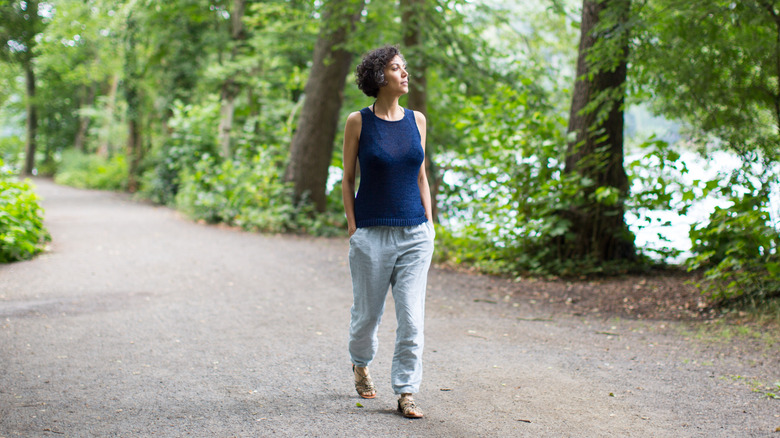How TikTok's 'Silent Walking' Trend Can Help Your Mental Health
Remember when 'Hot Girl Walk' was a thing on TikTok? Now the social media platform is back with a slightly different kind of walking: the silent walk. It's a movement that's getting influencers out of their homes (sans their mobile phones and by one's lonesome) and engaging in a form of light cardio by walking through nature or even just around their blocks. Proponents of the silent walking trend say that it's a time for reflection, clarity, and mental peace.
Some of you might be inclined to ask, 'Isn't that just walking before all the digital distractions came into our lives?' The answer is a little nuanced. First introduced by TikTok creator Mady Maio, silent walking isn't just about leaving your devices back at home for a 30-minute stroll. It's about being open to yourself and your thoughts. It's about centering yourself in the everyday rhythmic motion of walking. It's about mindfulness and meditation. It's also about hearing the quiet whispers in your head that are otherwise drowned out by the noises in your life, shared Maio.
Maio first tried silent walking when she took the advice of her nutritionist to try 30-minute walks instead of the "insane cardio" she was doing. She added to the practice her boyfriend's challenge to leave all distractions at home. The results, at least for Maio and others who've joined the bandwagon, have been life-changing. "I suddenly had the clarity that I've been always looking for," said Maio.
The 'silent walking' trend isn't something new
Lalah Delia, a certified spiritual practitioner and author of the mindfulness book "Vibrate Higher Daily: Live Your Power," told Today that silent walking isn't a new concept. "Zen Buddhist monks have long practiced silent walking under a different name which they call "walking meditation,'" explained Delia. Even before this trend came along, proponents of mindfulness have often talked about its mental health benefits. Unplugging from devices, distractions, and responsibilities to give space to your inner self can reduce stress and bring clarity and creativity.
In a world where we move from one task to the next, filling the little pauses we get by scrolling through our phones or sitting in front of the TV, until we get to bed at night and are finally alone with our thoughts for a few minutes before we drift off to sleep, silent walking is about embracing stillness during the day. In fact, according to Delia, much like sleeping, silent walking is another form of rest.
When you mindfully focus on your breathing, walking, surroundings, and the thoughts that flutter into your head, you're training yourself to stay in the present and hold space for your ruminations. As shared by triple board-certified psychiatrist Dr. Raafat W. Girgis (via Fox News), "Participants will learn how to reduce stress in areas of concern — from work and family to finance pressures and possibly even world affairs."
How to try silent walking
Moving away from the notion that we have to be productive, engaged, or multi-tasking at any given moment might be difficult at first, but persistence is key if you want to experience the benefits of silent walking.
If you want to try silent walking, leave your phone, AirPods, and pets at home, and make sure you're not hungry or thirsty before you go out. If you can't do 30 minutes, start with 10 and see where it leads. If boredom and racing thoughts are your first fears before attempting silent walking, the more you do it, the easier it will get, say the proponents. But for those with acute anxiety or depressive thoughts who rely on distractions like music and podcasts, seeing a mental health professional could help, offered Rael Cahn, Clinical Associate Professor of Psychiatry and the Behavioral Sciences at the Keck School of Medicine of USC (via Health).
While it might be ideal to silent walk through nature or at least areas that offer glimpses of trees and sounds of birds, this is not a must. If all you can do is get out and walk by yourself through sidewalks surrounding busy streets, that's okay, too. "Your environment doesn't necessarily need to be silent, but you do," psychologist Amanda Darnley told Today. And if for some reason, you can't get out and walk, try the trend at home much like you would silent yoga, mindfully walking in your living room while focusing on the movement of your body and breathing.


